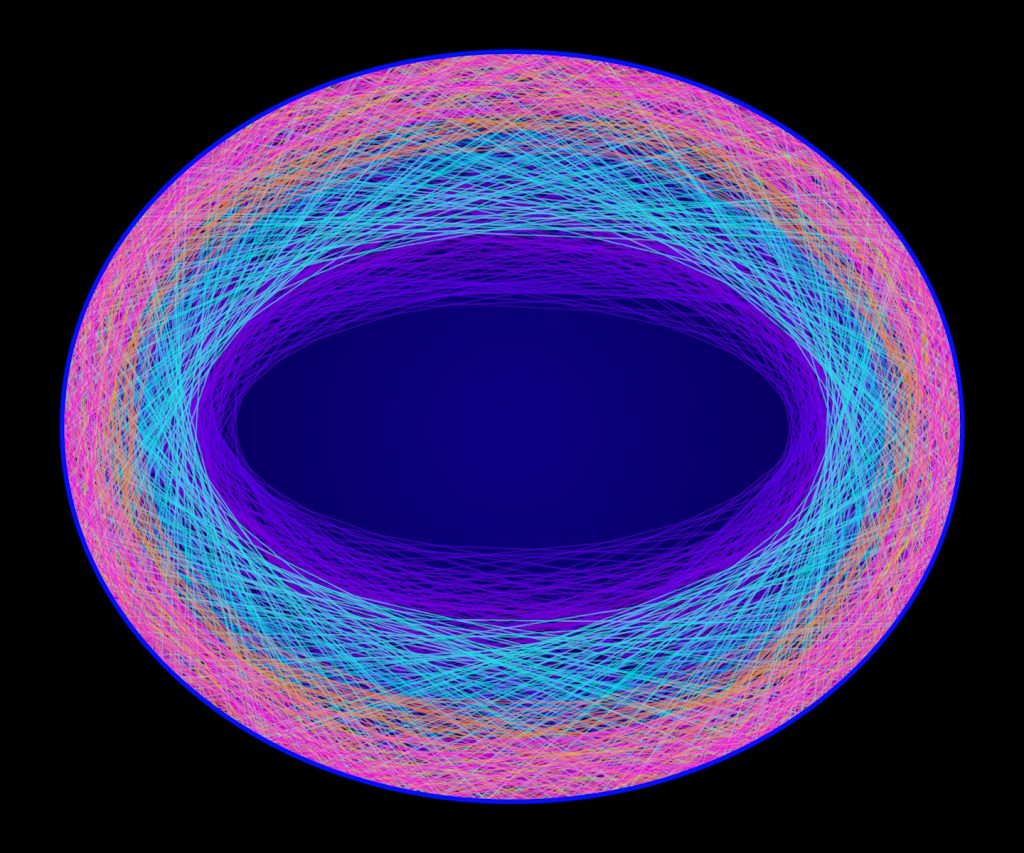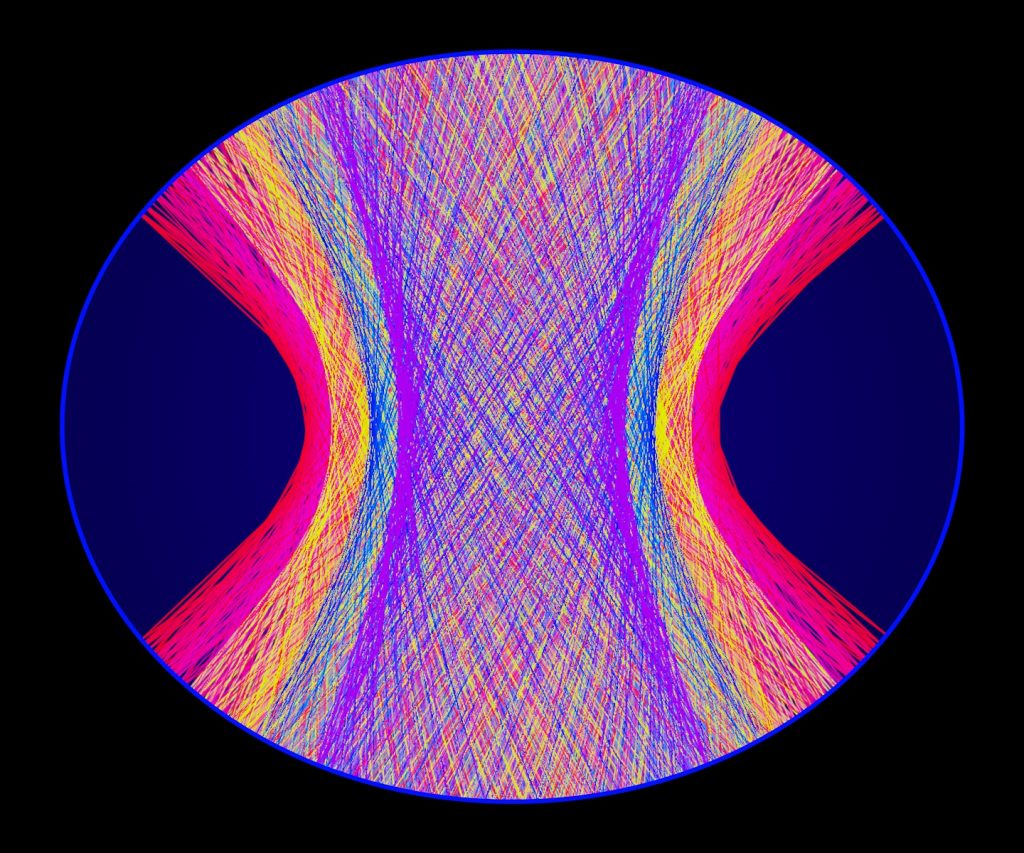AUTHOR : S. Tabachnikov :
EDITOR/ART : R. Ghrist :
This review concerns the following preprint:
M. Bialy and A. Mironov, The Birkhoff-Poritsky conjecture for centrally-symmetric billiard tables, https://arxiv.org/abs/2008.03566
Now published: M. Bialy, A. Mironov. The Birkhoff-Poritsky conjecture for centrally-symmetric billiard tables. Ann. of Math. (2) 196 (2022), no. 1, 389–413.
The dynamics of a billiard on a round disc is integrable. The interior of the disc is foliated by concentric circles which are caustics — a billiard trajectory, tangent to such a circle, remans tangent to it after each reflection in the boundary. A less trivial (but also well known) fact is that billiard dynamics on an ellipse is integrable as well: its caustics are the confocal ellipses and confocal hyperbolas (the former for the trajectories that do not intersect the segment connecting the foci, and the latter for the trajectories that intersect it).


About 100 years ago G. D. Birkhoff put forward the study of billiards in planar domains with smooth strictly convex boundaries (they are now called Birkhoff billiards). The conjecture, attributed to him and published by H. Poritsky [8], states that if a neighborhood of the boundary of a billiard table is foliated by caustics, then the table is elliptic. So far, this conjecture has resisted numerous attempts on its proof; one may call it the Holy Grail of the theory of mathematical billiards (or, at the very least, it is a serious contender for the title).
Much work has been dome recently toward Birkhoff conjecture; see [3, 6] for surveys. The present paper makes another serious step forward by proving the Birkhoff conjecture for centrally-symmetric $C^2$-smooth strictly convex planar billiards. Here is the main result.
Theorem: Assume that the phase space of a centrally symmetric Birkhoff billiard contains an invariant curve that goes around the cylinder once and consists of 4-periodic points. If the domain between this curve and the boundary of the phase cylinder is foliated by continuous invariant curves, then the billiard table is elliptic.
The strategy of the proof is a far-reaching extension of the approach taken by the first author in [1] where he proved a variant of Hopf rigidity for billiards: if the whole phase space of a billiard is foliated by non-contractible invariant curves, then the table is a round disc (Bialy successfully used variants of this approach in other papers too). The phase space of the billiard consists of the oriented chords $xy$ where $x$ and $y$ are points of the boundary of the table. The billiard ball map takes $xy$ to $yz$ where the angles made by these chords with the boundary at point $y$ are equal. Denoting by $S(x, y)$ the distance $|xy|$, one can describe the reflection by a variational principle:
$$ \frac{\partial}{\partial y}S(x,y) + \frac{\partial}{\partial y}S(y,z) = 0.$$
One says that $S$ is a generating function of the billiard ball map.
Another description of the phase space is in the spirit of geometrical optics: it is the set of oriented lines (rays of light) that intersect the billiard table. The space of oriented lines carries an area form that is invariant under the optical (i.e., billiard) reflection in every curve.
The first ingredient of the proof of the Theorem is the introduction of a new generating function of the billiard ball map, motivated by this optical description of the phase space. This non-standard generating function first appeared in [2].
The second ingredient of the proof is a precise description of the 1-parameter family of 4-periodic billiard trajectories (Theorem 4.1 of the paper). For example, each periodic quadrilateral is a parallelogram, and the tangent lines to the boundary of the billiard at its vertices form a rectangle (the fact that is well known for elliptic billiards, see [5]).
The third ingredient of the proof involves integral geometry. The existence of a foliation by invariant curves implies a certain integral inequality on the second partial derivatives of the generating function where integration is taken with respect to the phase area form which is invariant under the billiard ball map (this idea was successfully used in [1]).
One shows that this inequality is opposite to the Wirtinger’s inequality, and this implies that the boundary curve is an ellipse. Much technical heavy-lifting happens in this final part of the paper where the authors work with geometric inequalities. The paper also contains a number of interesting open questions that will stimulate workers in this field. For general information about mathematical billiards one may consult [4, 7, 9].
BIBLIOGRAPHY
[1] M. Bialy. Convex billiards and a theorem by E. Hopf. Math. Z., 214 (1993), 147–154. https://link.springer.com/article/10.1007/BF02572397
[2] M. Bialy and A. Mironov. Angular billiard and algebraic Birkhoff conjecture. Adv. Math., 313 (2017), 102–126. https://www.sciencedirect.com/science/article/pii/S0001870816300998
[3] M. Bialy and A. Mironov. A survey on polynomial in momenta integrals for billiard problems. Philos. Trans. Roy. Soc. A, 376 (2018), no. 2131, 20170418, 19 pp. https://doi.org/10.1098/rsta.2017.0418
[4] N. Chernov, R. Markarian. Chaotic billiards. Amer. Math. Soc., Providence, RI, 2006.
[5] A. Connes and D. Zagier. A property of parallelograms inscribed in ellipses. Amer. Math. Monthly, 114 (2007), 909–914. https://www.tandfonline.com/doi/abs/10.1080/00029890.2007.11920483
[6] V. Kaloshin, A. Sorrentino. On the integrability of Birkhoff billiards. Philos. Trans. Roy. Soc. A, 376 (2018), no. 2131, 20170419, 16 pp. https://royalsocietypublishing.org/doi/10.1098/rsta.2017.0419
[7] V. Kozlov, D.Treshchev. Billiards. A genetic introduction to the dynamics of systems with impacts. Amer. Math. Soc., Providence, RI, 1991.
[8] H. Poritsky. The billiard ball problem on a table with a convex boundary — an illustrative dynamical problem. Ann. of Math. 51 (1950), 446–470. https://www.jstor.org/stable/1969334?seq=1#metadata_info_tab_contents
[9] S. Tabachnikov. Geometry and billiards. Amer. Math. Soc., Providence, RI, 2005.
All figures (c) 2021 Robert Ghrist.
.

